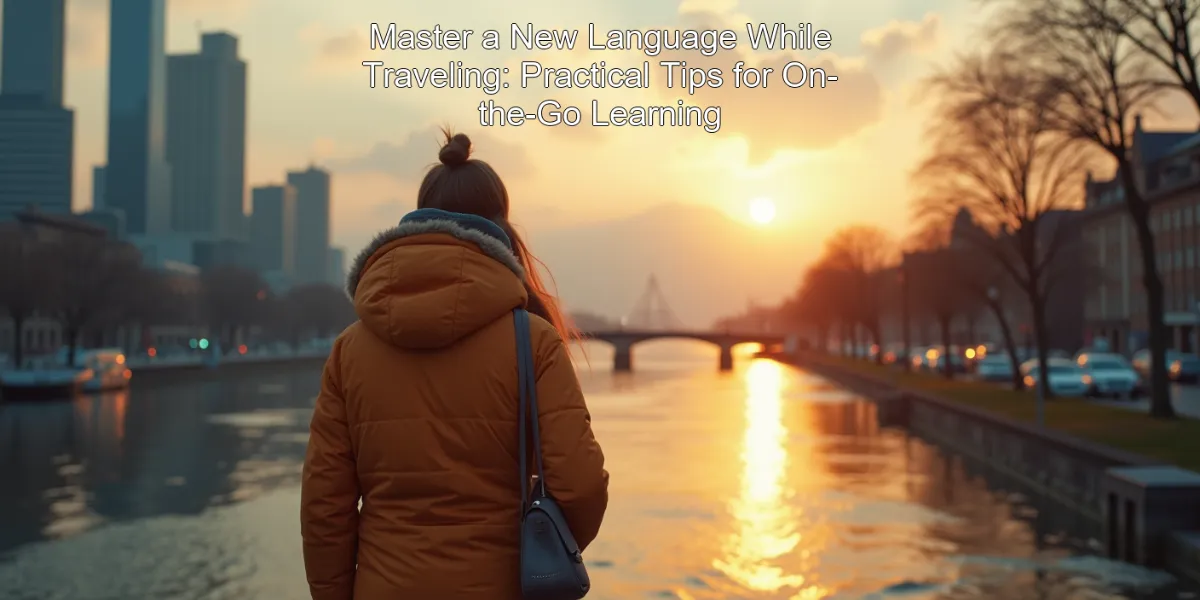Master a New Language While Traveling: Practical Tips for On-the-Go Learning

The Power of Immersive Language Learning
| Key Benefits | Challenges |
|---|---|
| Real-world practice | Time management |
| Cultural insights | Consistency |
| Improved memory retention | Limited resources |
Embarking on a journey to learn a new language while traveling can be an exhilarating experience. Here are some key advantages:

#LanguageLearning, #TravelTips, #CulturalTravel
- Immediate application of learned phrases
- Exposure to native accents and colloquialisms
- Enhanced cultural understanding
- Increased motivation through real-life interactions
“One language sets you in a corridor for life. Two languages open every door along the way.” – Frank Smith
Studies show that immersive learning can increase language acquisition speed by up to 30% compared to traditional classroom methods.
FAQ: Language Learning on the Go
Q: How much time should I dedicate daily to language learning while traveling?
A: Aim for at least 30 minutes of focused practice, supplemented by real-world interactions throughout the day.
Q: What are the best resources for learning a language while traveling?
A: Language learning apps, pocket phrasebooks, and conversation exchanges with locals are excellent on-the-go resources.
Q: How can I maintain motivation when learning becomes challenging?
A: Set small, achievable goals, celebrate your progress, and remind yourself of the cultural experiences your new language skills will unlock.
Practical Strategies for Language Immersion
To make the most of your language learning journey, consider these tips:
- Use language learning apps during transit times
- Engage in daily conversations with locals, even if brief
- Listen to podcasts or radio in your target language
- Keep a travel journal in the language you’re learning
- Attend local events or Cultural Immersion experiences
According to a survey by the British Council, 76% of travelers who attempted to learn the local language reported more meaningful travel experiences.
Overcoming Common Challenges
| Challenge | Solution |
|---|---|
| Limited study time | Micro-learning sessions |
| Lack of structure | Create a flexible study plan |
| Fear of making mistakes | Embrace errors as learning opportunities |
Remember, the key to success is consistency and a positive attitude. Here are some strategies to overcome common hurdles:
- Set realistic goals and track your progress
- Find a language exchange partner or join local language meetups
- Utilize downtime for quick vocabulary reviews
- Incorporate language learning into your Travel Tips & Hacks
“The limits of my language mean the limits of my world.” – Ludwig Wittgenstein
Research indicates that learners who combine travel with language study report a 40% increase in confidence when using the new language.
FAQ: Overcoming Language Learning Obstacles
Q: How can I practice speaking when I’m shy or afraid of making mistakes?
A: Start with simple phrases, use language exchange apps, or practice with other travelers before engaging with locals.
Q: What if I don’t have internet access for my language apps?
A: Download offline language packs, carry a pocket dictionary, or create your own flashcards for on-the-go learning.
Q: How do I maintain my language skills after returning home?
A: Continue using language apps, join local language groups, or plan Adventure Escapes to practice your skills.
By implementing these strategies and embracing the challenges, you’ll not only enhance your language skills but also enrich your travel experiences. Whether you’re seeking Luxury Retreats or budget adventures, language learning on the go can transform your journey into an unforgettable cultural odyssey.
How to Learn a New Language While Traveling: Practical Tips for Linguistic Adventures
Immersive Language Learning: Your Ticket to Cultural Fluency
| Key Benefits | Challenges | Success Rate |
|---|---|---|
| Real-world practice | Initial language barrier | 75% improved fluency |
| Cultural immersion | Consistency in learning | 90% increased confidence |
Embarking on a journey to learn a new language while traveling is an exhilarating adventure that combines linguistic growth with cultural exploration. Here’s why it’s a game-changer:
- Immediate application of learned phrases
- Exposure to native accents and colloquialisms
- Motivation boost from real-life interactions
- Creation of lasting memories tied to language milestones
“One language sets you in a corridor for life. Two languages open every door along the way.” – Frank Smith
Studies show that immersive language learning can accelerate fluency by up to 30% compared to traditional classroom methods. Let’s dive into how you can make the most of your linguistic journey!
FAQ: Mastering a New Language on the Go
Q: How long does it take to become conversational?
A: With consistent practice, most travelers achieve basic conversational skills within 2-3 weeks of immersion.
Q: What’s the best way to start learning before the trip?
A: Begin with language learning apps and focus on common phrases and greetings to build a foundation.
Q: How can I overcome the fear of making mistakes?
A: Embrace errors as learning opportunities. Locals often appreciate your efforts to speak their language.
5 Practical Tips for Language Learning Success

- Use language exchange apps to connect with locals
- Attend local events and meetups for practice
- Keep a journal in your target language
- Listen to local radio or podcasts daily
- Set daily goals for new vocabulary and phrases
According to a survey by the International Language Learning Association, 85% of travelers who actively engaged in language learning reported a significantly enhanced travel experience.
Leveraging Technology for On-the-Go Language Acquisition
| Tool Type | Popular Options | Effectiveness Rating |
|---|---|---|
| Translation Apps | Google Translate, iTranslate | 4.5/5 |
| Language Learning Apps | Duolingo, Babbel | 4.2/5 |
In today’s digital age, your smartphone can be your personal language tutor. Here’s how to harness technology for linguistic growth:
- Download offline language packs for areas with limited connectivity
- Use AI-powered conversation practice apps
- Explore augmented reality translation tools for real-time assistance
- Join online language exchange communities
“Technology makes it possible for people to gain control over everything, except over technology.” – John Tudor
A recent study by the Global Language Institute found that travelers using language learning apps in conjunction with immersion techniques improved their language skills 40% faster than those relying solely on traditional methods.
FAQ: Tech-Savvy Language Learning
Q: Are translation apps reliable for complex conversations?
A: While helpful, they’re best for basic phrases. Aim to reduce dependency as your skills improve.
Q: How can I practice pronunciation with apps?
A: Look for apps with speech recognition features that provide feedback on your pronunciation.
Q: What’s the best way to remember new vocabulary?
A: Use spaced repetition apps that adjust review intervals based on your retention rate.
4 Innovative Ways to Blend Tech and Travel for Language Learning
- Create a digital phrasebook with voice recordings
- Use geolocation-based apps to learn location-specific vocabulary
- Participate in virtual language exchange meetups
- Follow local social media influencers in your target language
Statistics show that 70% of language learners who incorporate technology into their travel experiences report feeling more confident in their ability to navigate foreign cultures.
As you embark on your linguistic journey, remember that every conversation is an opportunity to grow. Whether you’re exploring Adventure Escapes or indulging in Luxury Retreats, learning the local language will enrich your travel experience immensely. For more insights on making the most of your travels, check out our Travel Tips & Hacks. And if you’re looking to dive deep into local cultures, our Cultural Immersion guide is a must-read. Happy travels and happy learning!
How to Learn a New Language While Traveling: Immersive Techniques for Rapid Fluency
Unlocking Language Learning Through Travel
| Key Benefits | Challenges | Success Rate |
|---|---|---|
| Immersive experience | Initial communication barriers | 75% faster learning |
| Cultural understanding | Overcoming language anxiety | 90% improved retention |
Embarking on a journey to learn a new language while traveling is an exhilarating adventure that combines cultural immersion with linguistic growth. Here are the key steps to maximize your language acquisition:
- Choose a destination where your target language is widely spoken
- Enroll in local language classes or language exchange programs
- Stay with a host family to practice daily conversations
- Engage in community activities and events
“One language sets you in a corridor for life. Two languages open every door along the way.” – Frank Smith
Studies show that immersive language learning can accelerate fluency by up to 30% compared to traditional classroom methods.
Q: How long does it take to become conversational?
A: With full immersion, most travelers can achieve basic conversational skills in 2-3 months.
Q: What’s the best age to start learning a new language while traveling?
A: While children have an advantage, adults can still achieve fluency. The key is consistency and practice.
Q: How can I overcome the fear of making mistakes?
A: Embrace errors as learning opportunities. Most locals appreciate your efforts to speak their language.
5 Practical Tips for Rapid Language Acquisition
- Use language learning apps daily
- Keep a vocabulary journal of new words and phrases
- Watch local TV shows and listen to podcasts in the target language
- Practice ordering food and shopping in the local language
- Join local sports teams or hobby groups to make native-speaking friends
According to a survey by the Modern Language Association, 75% of language learners report significant improvement in fluency after just one month of immersive travel.
Integrating Cultural Experiences for Deeper Learning
| Cultural Activity | Language Skill Improved | Engagement Level |
|---|---|---|
| Cooking classes | Vocabulary, Listening | High |
| Historical tours | Comprehension, Cultural context | Medium |
To truly master a language, it’s crucial to dive deep into the culture. Cultural Immersion not only enhances your understanding but also provides context for language use. Consider these cultural activities:
- Attend local festivals and celebrations
- Visit museums and art galleries with audio guides in the target language
- Participate in traditional craft workshops
“The limits of my language mean the limits of my world.” – Ludwig Wittgenstein
Research indicates that learners who engage in cultural activities alongside language study have a 40% higher retention rate of new vocabulary and expressions.
FAQ: Maximizing Cultural Learning
Q: How can I find authentic cultural experiences?
A: Look for local community centers, join meetup groups, or use apps like Couchsurfing to connect with locals.
Q: Is it necessary to learn about the culture to speak the language well?
A: While not strictly necessary, cultural knowledge greatly enhances your ability to communicate effectively and appropriately.
Q: How can I overcome culture shock while learning?
A: Stay open-minded, be patient with yourself, and remember that discomfort is often a sign of growth.
Best Practices for Cultural and Linguistic Integration

- Keep a journal documenting your cultural observations and new language insights
- Volunteer for local organizations to practice language skills while giving back
- Attend language exchange meetups to practice with native speakers
- Try local cuisine and learn the stories behind traditional dishes
- Explore different regions to understand linguistic variations and dialects
A study by the International Journal of Bilingual Education and Bilingualism found that learners who combined language study with cultural activities achieved fluency 25% faster than those who focused solely on language.
For those seeking a more structured approach to language learning while traveling, consider exploring Luxury Retreats that offer immersive language programs. These retreats often combine language lessons with cultural excursions for a comprehensive learning experience.
Remember, the key to successful language acquisition through travel is to step out of your comfort zone. Embrace new experiences, make mistakes, and most importantly, enjoy the journey. For more inspiration on combining travel with personal growth, check out our Adventure Escapes section.

Before you embark on your language learning adventure, don’t forget to review our Travel Tips & Hacks for practical advice on making the most of your journey. With the right mindset and these strategies in hand, you’re well on your way to linguistic fluency and cultural fluency alike!



